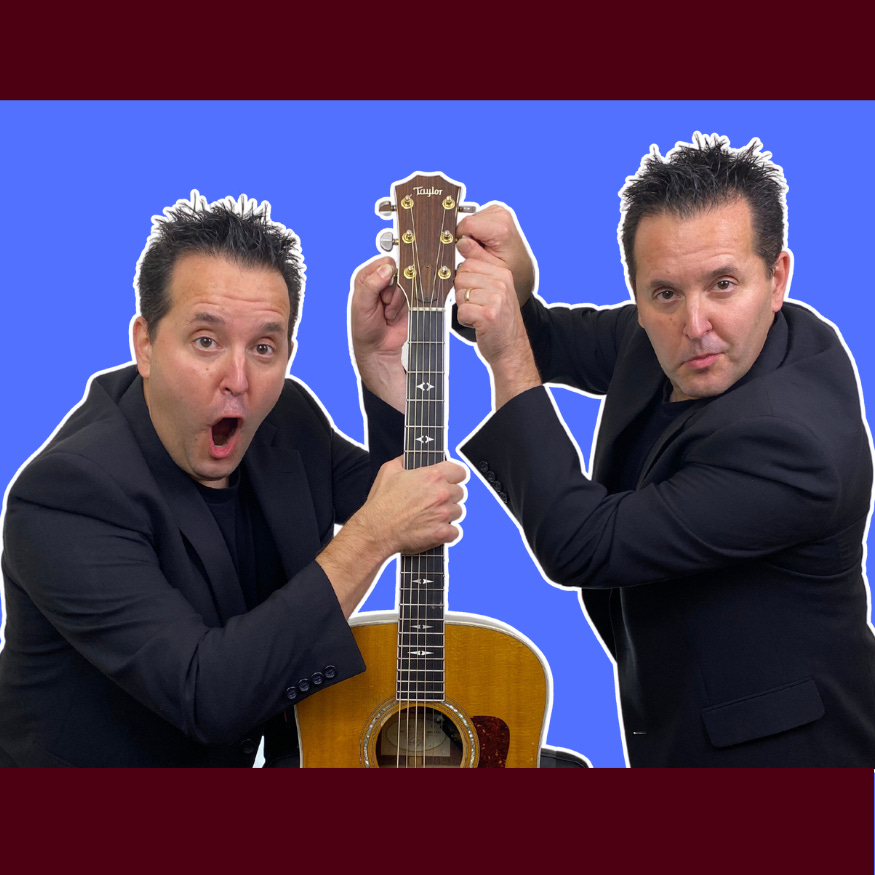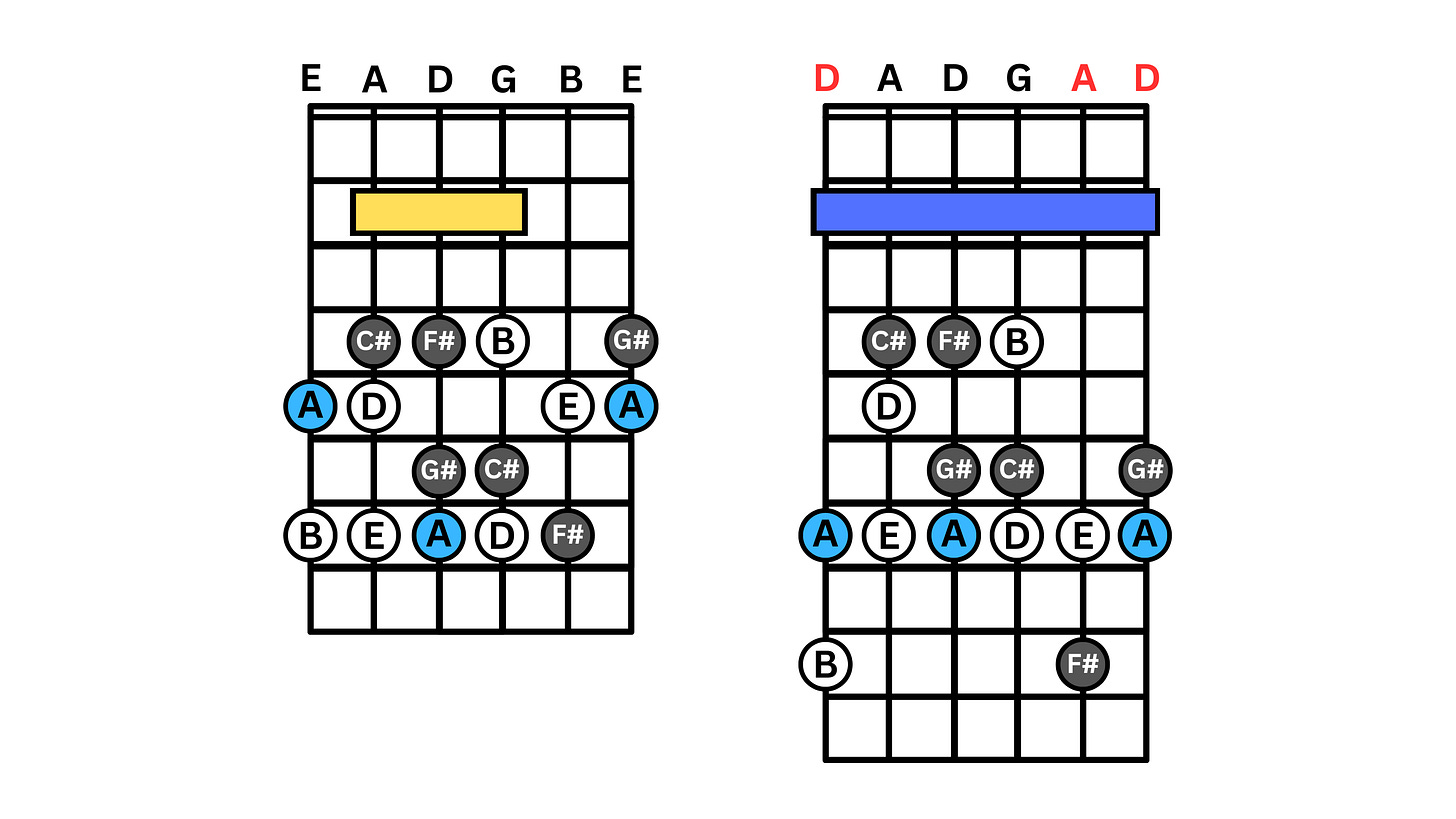Pro tip: please watch the short video version of this post that I link to www.GuitarSuccess4U.com/10AlternateTuningMyths. It will give you a much clearer grasp of what I’m sharing here.
Abbreviated transcript and table included below…
Have you always wanted to play in alternate tunings, but felt a little intimidated by the process? Not anymore.
Let’s dispel 10 myths together and find some hidden treasures when it comes to alternate tunings.
The 6 machine heads on our guitars are like a 6-digit combination lock, and the alternate tunings we can access with them can be incredibly enjoyable. Here are 10 myths I’m going to dispel about alternate tunings. You ready?
Myth #1 – “Alternate tunings are too difficult to get into.”
By definition, an alternate tuning is any tuning that’s different from standard tuning, so even Drop-D can fall into this category. This is the best place to start. All you do is start with a standard-tuned guitar and then tune one string down – your 6th string, until the 12th fret harmonic matches the open 4th string D (watch the video to see how.)
Myth #2 – “Alternate tunings can be achieved with a partial capo.”
If were to take a standard tuned guitar and place a partial capo on strings 5, 4, and 3 on the second fret, and play those notes open, they would sound an Esus4.
If I tune another guitar to DADGAD and place the capo on the second fret, I’ll have access to the same open notes that sound an Esus4. And although some of the chords might sound similar on both guitars (see the video), that’s where the similarity between the partial capo and the alternate tuning end.
Look at this closed voicing A Major scale on a standard-tuned guitar with a partial capo, and contrast it to a DADGAD capo 2 guitar.
Myth #3 – “You can figure out the tuning of a guitar from an audio recording.”
Sometimes. Not always. I wrote a song in DADGAD and recorded it on an album with my capo on the 3rd fret. Later, a friend liked the song so much that he taught it to himself from the recording, and played it in standard tuning, but with a lot more fretted notes.
Myth #4 – “The tuning dictates the key.”
Not necessarily. I actually learned a beautiful fingerstyle song by Pierre Bensusan in DADGAD while studying with him in France called “L’Alchimiste,” and that song was in DADGAD but in the keys of C and F Major…without a capo. Pretty wild.
Myth #5 – “Alternate tunings require a dedicated guitar.”
I think it depend on how quickly you can re-tune. I caught Michael Hedges in concert a couple times and he had two 6-string guitars for the whole show – one he played onstage, while his technician re-tuned the other one offstage.
He must have played in upwards of two dozen tunings with just those two guitars. At my concerts and when I lead worship, I use at most, three guitars. I try to keep my guitars in neighboring tunings as well, and to plan my sets accordingly.
Myth #6 – “Each tuning takes a long time to learn to play in.”
Actually, once you’ve re-tuned, you can be creating great music in minutes. There’s something sweet about exploring a new tuning for the first time, and finding chord voicings that are just not possible in standard tuning or even partial capo positions.
Myth #7 – “Once you re-tune, you have to re-learn the instrument.”
As I mentioned, you don’t have to re-learn everything in a new tuning. Some strings, if they remain in their original pitches, can allow for some of the same figures we know, like three-string chord voicings or melodic fragments.
Some tunings are nice for specific textures, drones, or certain keys. But a new tuning doesn’t necessitate re-learning the entire guitar from square one.
Myth #8 – “Alternate tunings require special string gauges.”
If we keep the same strings proprietary to their standard locations on the guitar, I recommend medium gauge – 13 to 56, from high to low, because a set of these strings splits the difference between the heavy gauge strings and light gauge strings.
Myth #9 – “Your tunings drastically affect your collaborators’ choices.”
As long as you’re in concert pitch and playing chords or melodies, this really doesn’t affect your collaborators in a major way.
You might have a little fun mystifying your bass player who thinks they know which notes you’re playing, especially on your low strings, but no, tunings don’t affect other musicians, at least not logistically. They may actually inspire your collaborators artistically, which could be really cool. Lastly…
Myth #10 – “There are only a limited number of alternate tunings out there.”
Think about my analogy of a combination lock for a moment. There are lots of possibilities, especially if there are six digits on your lock. If we were to compute each string as having a combined range of an octave (in other words, each string could theoretically be tuned down a Perfect 5th and up a Major 3rd), how many alternate tuning possibilities could there be on a 6-string guitar? Answer: 2,985,984 tunings!
A six-string acoustic guitar in good shape is primed and ready for exploring alternate tunings, so I encourage you to step out and take the risk.
Who knows? You might write an arrangement or a brand-new song in a new tuning…today. Maybe you’ll find a way to arrange a worship song you love, in an alternate tuning, perhaps combined with a capo across all 6 strings for the key where it works best for your voice, your band, or both. I hope you do.
As we wrap up, without going too deep into a discussion about gear, I will say that there are automated tuners, tuning levers and pegs that can be added to a guitar to customize the precision and speed with which someone can re-tune their guitar. Guitarist Adrian Legg is a prime example of someone who has leveraged these kinds of tools.
But a six-string acoustic guitar in good shape is primed and ready for exploring alternate tunings, so I encourage you to step out and take the risk. Who knows? You might write an arrangement or a brand new song in a new tuning…today. Maybe you’ll find a way to arrange a worship song you love, in an alternate tuning, perhaps combined with a capo across all 6 strings for the key where it works best for your song, your band, or both. I hope you do.
And if you’re looking for more insights into discovering some hidden treasures that the guitar and music have to offer, I would be honored to be your guide in a one-of-a-kind online experience called GuitarSuccess4U. I’ve never seen anything like what we have, therefore, I had to create it. We have a 6-stage Success Path, proven strategies for multi-modal learning, a collection of hand-picked guest experts, and a community of like-minded Christian guitarists who just might be on a similar journey to you.
Will you discover what we’ve worked so diligently to create? Please take a moment to visit GuitarSuccess4U.com and see what we’re up to. It could change your guitar world, and transform your musical world.
I hope to see you inside GuitarSuccess4U. Keep showing up, have serious fun as you play your guitar, and I’ll see you next time.














Share this post